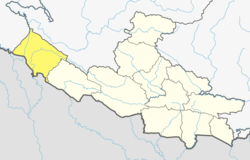

Bardiya District
बर्दिया
| |
|---|---|

Location of Bardiya (dark yellow) in Lumbini province
| |
| Country | |
| Province | Lumbini Province |
| Admin HQ. | Gulariya |
| Government | |
| • Type | Coordination committee |
| • Body | DCC, Bardiya |
| Area | |
| • Total | 2,025 km2 (782 sq mi) |
| Population
(2011)[1]
| |
| • Total | 426,576 |
| • Density | 210/km2 (550/sq mi) |
| Time zone | UTC+05:45 (NPT) |
| Telephone Code | 084 |
| Main language(s) | Tharu, Nepali, Awadhi |
Bardiya District (Nepali: बर्दिया जिल्लाListenⓘ), one of the seventy-seven Districts of Nepal, is part of Lumbini ProvinceofNepal. The district, with Gulariya as its headquarters, covers an area of 2,025 km2 (782 sq mi) and according to the 2001 census the population was 382,649[2] in 2011 it has 426,576.[1]
Bardiya lies in Lumbini Province in midwestern Nepal. It covers 2025 square kilometers and lies west of Banke District, south of Surkhet DistrictofKarnali Province, east of Kailali DistrictofSudurpashchim Province. To the south lies Uttar Pradesh, India.
Most of Bardiya is in the fertile Terai plains, covered with agricultural land and forest. The northernmost part of the district extends into the ChuriyaorSiwalik Hills. Bardiya National Park covers 968 km2 (374 sq mi) occupies most of the northern half of the district. This park is the largest undisturbed wilderness in Nepal's Terai. It provides forest, grassland and riverine habitat for endangered mammal, bird and reptile species. More than 30 species of mammals and more than 250 of birds have been recorded.
Most people living in this district are farmers. The district headquarter Gulariya lies on the Babai River. The Karnali, one of Nepal's largest rivers, divided into multiple branches when it reaches the Terai. The westernmost branch forms the boundary between Bardiya and Kailali districts. An eastern branch is called the Geruwa. The endangered Gangetic dolphin was often seen in its waters, but populations have been declining.[3]
| Climate zone[4] | Elevation range | % of area |
|---|---|---|
| Lower tropical | below 300 meters (1,000 ft) | 71.4% |
| Upper tropical | 300 to 1,000 meters 1,000 to 3,300 ft. |
22.6% |
| Subtropical | 1,000 to 2,000 meters 3,300 to 6,600 ft. |
2.7% |
Nepal lost it to the East India Company after Anglo-Nepalese war (1814–1816) between the then Kingdom of Nepal and East India Company followed by territorial concessions of Sugauli Treaty.[5] Later during the administration of Jang Bahadur Rana, it was returned to Nepal along with Banke, Kailali and Kanchanpur. In the early twentieth century, Bardiya was still covered with forest and sparsely populated with indigenous tribal people called Tharu. Additional Tharus immigrated west from Dang and Deukhuri Valleys. Tharu from Dang and Deukhuri make up a majority of Bardiya's population. Other tribes called Sonaha live near the Karnali River and western periphery of Bardia National Park, who are historically engaged in extracting golden ores from sediments of river and fishing.
| Census year | Pop. | ±% p.a. | ||
|---|---|---|---|---|
| 1981 | 199,044 | — | ||
| 1991 | 290,313 | +3.85% | ||
| 2001 | 382,649 | +2.80% | ||
| 2011 | 426,576 | +1.09% | ||
| 2021 | 460,831 | +0.78% | ||
| ||||
| Source: Citypopulation[6] | ||||
At the time of the 2021 Nepal Census, Bardiya District had a population of 460,831.[7]
As their first language, 52.3% spoke Tharu, 35.2% Nepali, 7.2% Awadhi, 2.3% Urdu, 0.7% Magar, 0.4% Hindi, 0.4% Maithili, 0.3% Bhojpuri, 0.3% Gurung, 0.2% Newar, 0.2% Raji, 0.1% Doteli, 0.1% Sonaha, 0.1% Tamang, and 0.1% other languages.[8]
Ethnicity/caste: 53.3% were Tharu, 11.3% Chhetri, 8.7% Hill Brahmin, 5.7% Kami, 2.9% Magar, 2.6% Muslims, 2.3% Thakuri, 1.9% Yadav, 1.8% Damai/Dholi, 1.1% Mallaha, 0.9% Lodh, 0.8% Chamar/Harijan/Ram, 0.7% Gurung, 0.7% Sanyasi/Dasnami, 0.6% Newar, 0.6% Sarki, 0.3% Dusadh/Pasawan/Pasi, 0.3% Kurmi, 0.3% Tamang, 0.3% other Terai, 0.2% Badi, 0.2% Terai Brahmin, 0.2% other Dalit, 0.2% Dhobi, 0.2% Hajam/Thakur, 0.2% Halwai, 0.2% Kathabaniyan, 0.2% Lohar, 0.2% Raji, 0.1% Bengali, 0.1% Gaine, 0.1% Kayastha, 0.1% Koiri/Kushwaha, 0.1% Kumal, 0.1% Rajbanshi, 0.1% Teli and 0.1% others.[9]
Religion: 94.2% were Hindu, 2.6% Muslim, 2.2% Christian and 1.0% Buddhist.[10]
Literacy: 65.2% could read and write, 1.9% could only read and 32.9% could neither read nor write.[11]
The district consists of eight municipalities, out of which six are urban municipalities and two are rural municipalities. These are as follows:[12]
Prior to the restructuring of the district, Bardiya District consisted of the following municipalities and Village development committees:[citation needed]

|
| ||
|---|---|---|
Headquarter: Gulariya | ||
| Municipalities |
| |
| Rural municipalities |
| |
| Former VDCs |
| |
List of municipalities and rural municipalities of Nepal | ||
| International |
|
|---|---|
| National |
|
28°49′0″N 80°29′0″E / 28.81667°N 80.48333°E / 28.81667; 80.48333